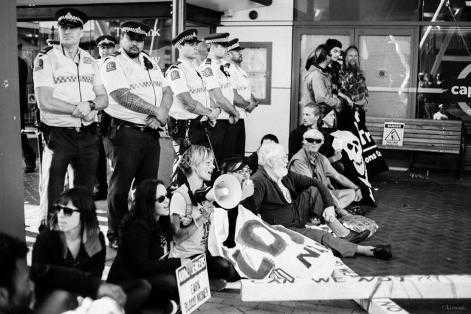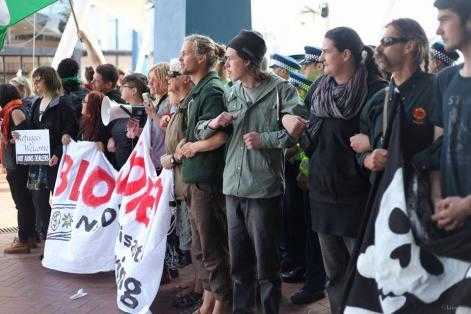Stopping the weapons conference
New Zealand is a place often associated with its nuclear-free position, and it rates highly on the global peace index. In spite of a relatively bucolic lifestyle downunder, New Zealand’s capital city, Wellington, plays host to an annual weapons conference in November where about 550 delegates representing 165 companies converge for an annual weapons conference.
The conference, hosted by the NZ Defence Industry Association, and sponsored by Lockheed Martin has been the focus of an on-again, off-again campaign over fifteen years. Resistance to the conference has largely been organised by grassroots community group, Peace Action Wellington (PAW), and as such it has not always had the capacity to follow through on the campaign over successive years. This is one of the most significant factors limiting the success of the campaign.
This year, PAW has spent considerable time and energy on the campaign. There were some strategies pursued and some victories achieved. This article talks about what those are. Needless to say, there is still some work to do before the conference is abandoned entirely.
PAW began organising for the conference in late June with a clear message to “stop the weapons conference” and “shut it down.” From the outset, the group was committed to using direct action at the conference, while following other political avenues in the lead-up to the actual day.
The campaign began in a relatively low-key fashion focusing energy on the Mayor of Wellington who holds the position of executive leader of the international “Mayors for Peace” organization. The weapons conference has been held at council-owned venues for the last two years, and thus, the Mayor was an obvious person to get on board. She was hosting a number of peace events giving PAW a context and an opportunity to challenge her to support our campaign.
Her response was disappointing to say the least. She likened the conference to a yoga conference or a sustainable living expo, and at one point said she didn’t see the relationship between the conference and the proliferation of nuclear weapons (the main purpose of the Mayors for Peace being the abolition of such weapons). We wrote to the other so-called mayors of peace asking them to encourage our Mayor to take a principled position without getting the slightest bit of support from any of them.
As a result, PAW took to the streets with a community petition and regular stalls with display boards, leaflets and later t-shirts, bags and badges. We specifically decided not to use an online petition because we wanted to engage with people on the streets, not the already “converted” and to really make the link for people with their own town as the host for the event.
At the same time, members of PAW organised to meet individually with members of the city council to lobby them to support our petition. Most were very supportive.
That part of the organising continued while PAW turned its attention to the conference and conference attendees. Over the next couple of months, members of the group filed numerous official information act requests and did extensive research focusing on the New Zealand government’s support for the industry. The research was published as a report entitled Profiting from War, and it gave members of the group an intimate knowledge of the industry as well as some avenues for further research.
Information from the report was used to make campaign infographics. These infographics were very powerful tools for helping people to see the costs of militarism in terms of health care, education and housing. PAW also produced a series of these infographics on how NZ was supporting the occupation of Palestine.
Part of the PAW campaign approach was to utilize social media platforms, and the infographics were distributed via both facebook and twitter. In the two-week lead up to the conference, PAW spent approximately NZ$100 on facebook “boosting” of posts that had photographs of previous blockades, encouraging people to join in the action. This garnered significantly more views, “likes” and shares than anything else posted, however, it did not translate to people at the blockade on the day. In spite of this, reaching so many people provided a major boost to wider public support for the campaign.
PAW also sought to gain support from other community organisations early in the campaign. These included other peace groups, churches, unions and campaigns. While this was only minimally successful in terms of getting groups to endorse a statement of opposition, it had the effect of alerting these organizations about the event.
Meanwhile, the group worked to create a set of posters and a large banner with a unified “logo”(borrowed from the Australian Peace Convergence, it is the image of a toy soldier breaking his gun in half over his knee). The design was simple and boldly featured the picture. The posters were regularly distributed through town, and smaller leaflets with more extensive information on the other were created. The banner hung from a very prominent place next to the entrance ramp to the local motorway.
The group built internal solidarity and trust with regular “resource making” evenings where members went postering and stenciling together, painted banners and created props.
A month prior to the start of the weapons conference, PAW presented 1000 signatures to the Wellington City Council. The purpose of the petition was largely as an organising tool, but it also had value to bring the issue to a head at the council as the provider of the venue for the conference. A right-wing councilor shut down all debate on the petition, and this was reported as a serious transgression of normal democratic process. Sympathetic councilors were appalled and advised about further political avenues to pursue with a view towards getting the council to adopt an ethical stance on the use of its venues.
The weekend before the blockade, PAW held a non-violent direct action (NVDA) training session for the public. This was a lovely Saturday four-hour session (including a great lunch) adapted from a London Palestine Action training. This helped many people feel more prepared to take action, and to have questions answered about legal possibilities.
The group also created a wide range of props and activities for the blockade. These included some large danger posters with “crime scene” tape to be deployed on doors around the venue; white ribbons with the names of drone victims on them to be tied to fences, and a shopping trolley of faux weapons to be pushed around in some street theatre. A one-quarter-size predator drone model from a previous action was deployed on the day to provide some additional visual imagery.
The night before the action, PAW held a public action briefing to give people as much confidence about what might happen on the day, and to let them know what things to bring. Each person was given a map and conference timetable, legal details and space was made for people to discuss any specific gear for the blockade.
On the morning of the first day of the conference, people gathered at a local park just a block away from the conference. There people were given another short briefing; maps, timetables, bust cards, chant sheets and media sound bites were distributed. The group was split into three with each taking a different entrance at the conference venue (there were significantly more entrances).
The number of people in attendance was about 150. The blockade at the front of the building deployed amidst large numbers of police. The police had erected a barrier fence about waist high around the venue with a large opening on one side. On that side, the entrance was continuously blockaded while on the other side, impromptu blockades and skirmishes with police erupted each time a delegate attempted to enter.
A blockade of the loading entrance was successful for some hours, and subsequently a smaller group deployed to the underground carpark where they locked on inside the elevator/stairwell entry.
During the blockade, the response of police was heavy-handed with 26 people in total arrested for a range of charges including trespass, obstruction and assaulting police.
Once the conference was underway, and most of the arrests had happened, the remaining crowd moved to a noise blockade: the conference plenary sessions were easily targeted through two emergency exits.
Day two of the conference only involved a disruptive noise demonstration outside the conference awards dinner. Sadly, the relatively small population and high arrest rate meant that it was unsustainable to fully target both days of the conference.
There was widespread media coverage of the event, and the Minister of Defence was forced to try and justify the conference claiming it was mostly about selling socks and cups.
The next steps for the group are supporting the arrestees and continuing pressure on the council. It may also mean targeting the two major supporters of the industry: New Zealand Trade & Enterprise (a trade promotions agency) and the NZ Super Fund, a major investor in the industry.
While it is not difficult to garner support against a weapons conference, serious challenges remain in a wider sense in moving public opinion from a widely held belief in the beneficent activities of the NZ military. Successive governments have cleverly and successfully deployed the rhetoric of “peacekeeping”, “reconstruction” and “training” to distract the public from the 14 years of continual war that the New Zealand has been a very active participant in.
This action was the first attempt at blockading the conference since 2006, and it was quite a success, given the long absence of any significant activity around it.


Add new comment